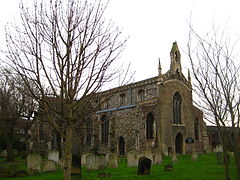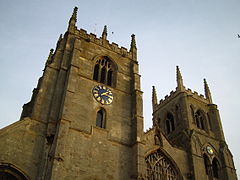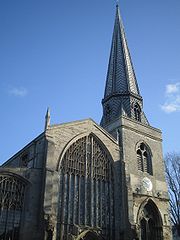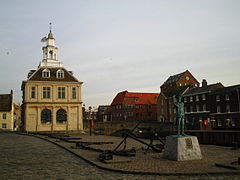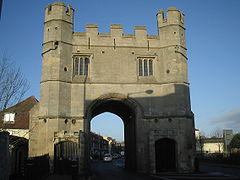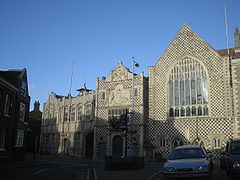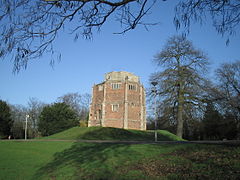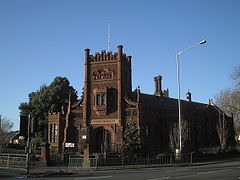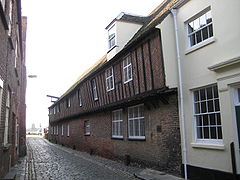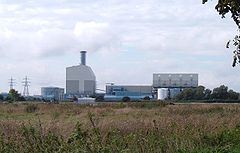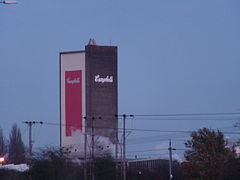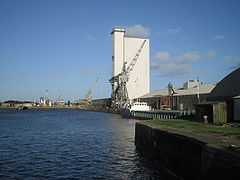- List of buildings in King's Lynn
-
King's Lynn is an English market town in West Norfolk. This list details a selection of some of the more prominent buildings in the town.
Contents
Churches
All Saints' Church
All Saints' Church (52°44′58″N 0°23′58″E / 52.7494°N 0.3994°E) predates the Domesday Survey of c. 1095, where it is described as All Hallows, in a reference to the founding of a Cluniac priory by Lord Ralph de Tony. The church is known today for the Anchorhold room located on the south side of a church. For a period of several centuries it was occupied by cloistered Anchorite women.[1]
St Margaret's Church
The construction of St Margaret's Church (52°45′06″N 0°23′43″E / 52.7516°N 0.3954°E) in 1101 is the point at which King's Lynn first came into existence in terms of how it is now recognised today. Commissioned by the Bishop of Norwich, Herbert de Losinga, at the request of the townspeople 'in honour of the Holy Mary Magdalene and St Margaret and all holy virgins', the church is one of the town's most dominating landmarks.[2]
The church has seen substantial redevelopment over the centuries - at its peak it had a library in a wing to the south. The church also had a spire on the south west tower and a central lantern similar to Ely Cathedral - these were destroyed by lightning in the 18th century.
Of the original structure, it is believed that only the bottom portion of the south west tower is original. The church was first rebuilt in the 13th century at the request of the Bishop of Norwich - Bishop de Grey. Of this rebuild only the chancel remains.
The north west tower had to be rebuilt in 1453, as it had been set in poor foundations. Although it is still safe to stand for a few more centuries, if you enter the church you can see just how dramatic the lean is.
During the siege of Lynn in the 15th century, pot shots were taken at the church, damaging various religious embellishments and, most significantly, the main Western window. The cannonball that destroyed the window now hangs in the entrance to Hampton court, nearby to the church.
The most serious damage to the church occurred in 1741, when a great storm destroyed the spires of St Margaret's church and St Nicholas' Chapel as well as St Margaret's central lanteen. Despite generous donations totalling £1,000 from George II and Robert Walpole, the £3,500 required was not raised, and the church was not able to be restored to its former glory.
The sixteen misericords date from 1370 to 1377. These predominately feature heads; for instance, S-02 is the head of Edward the Black Prince. The supporters are mainly floral / foliate.
The church is a Grade I listed building.[3]
St Nicholas' Chapel
St Nicholas' Chapel (52°45′27″N 0°23′49″E / 52.7575°N 0.3970°E) was constructed around 1200, during the expansion of Lynn by Bishop William Turbus, the third Bishop of Norwich. The expansion saw not only the construction of the chapel, but also the Tuesday Market Place, which is still the primary marketplace in the town today. Consequently, the chapel quickly became Lynn's second church by a comfortable margin. It was not long before it was so popular that it launched pleas to become an independent parish from St Margaret's Church; in 1426 St Nicholas' Chapel had congregations of 1,400 - compared to 1,600 at St Margaret's. Despite this, it took until 1627 before the chapel obtained baptismal rights.
Due to its rise in popularity, and the fact that the north of Lynn became quite affluent, the chapel was rebuilt between 1380 and 1410 on a much larger scale in the grand perpendicular scale of the time.
The church is England's largest chapel of ease, a chapel dependent on a church and serving part of the parish for the convenience of parishioneres nearby. It is worth visiting not only for the building itself, but also for the human stories it tells.[4]
The church is most distinctive for its tall spire, although it is not the original. There were at least two spires previously - one of which was destroyed in the storm of 1741 (along with the spire and lantern of St Margaret's), and another which stood from 1749 to 1854 (described as 'never a regular spire but a kind of wooden extinguisher stuck on to be seen at sea').[5]
The chapel is a Grade I listed building.[6]
Historical buildings
Custom House
The King's Lynn Custom House (52°45′14″N 0°23′37″E / 52.7538°N 0.3935°E) is one of the town's most iconic landmarks. It was designed by architect Henry Bell and built by Sir John Turner in 1685. It was not the first Custom House built for the town - originally one was constructed in 1620 on the site where the Hogge Mansion is currently located (currently occupied by Barclay's Bank); however, this was too small and as a result a larger one was needed; St George's Guildhall was used in the intervening years.
Initially, Customs only occupied the top floor and the ground floor was used by merchants for trading; however, merchants were unhappy that they were so far from the Tuesday Market Place, and by 1717 Customs occupied the entire building.
Three centuries later, whilst the building is no longer used by Customs, it is still a gateway to the town, as it houses the town's Tourist Information Office. It is also a Grade I listed building.[7]
The building was described by architect Nikolaus Pevsner as "one of the most perfect buildings ever built".[8] He was an admirer of King's Lynn in general, also commenting that the walk from the Tuesday Market Place to the River (by the Customs House) was of the finest in the world.[9]
Greyfriars Tower
The Greyfriars Tower (52°45′05″N 0°23′56″E / 52.7514°N 0.3990°E) is the only remaining part of the Franciscan monastery on this site, and one of only three surviving Franciscan monastery towers in England and is considered to be the finest.[10] It is a Grade I listed building.[11]
Following the Dissolution of the Monasteries by Henry VIII all such monasteries were demolished. The tower at Lynn remained because it was considered to be a useful seamark by sailors entering the town, still being clearly visible on the town's skyline to this day.
The tower is informally referred to as 'the leaning tower of Lynn'[12][13][14] as it leans dramatically to the west. At its worst, the lean was 67.5 centimetres - which given its height of more than 28 metres is just over 1 degree. This compares to 3.98 degrees on the Leaning Tower of Pisa.[15]
Although it is not believed to be in imminent danger of collapse, until recently it did require work to correct the lean to ensure it remains a part of the King's Lynn skyline. This was completed by August 2006 and on October 18, 2006 the grounds were officially opened by the Mayor, Councillor Ann Clery-Fox. It was once forecast that the tower would collapse onto the Theatre Royal next door when the Queen came to visit - however as the theatre has since been converted into a bingo hall this now seems unlikely.
The tower itself was featured in the first season of the BBC TV series Restoration[12] for the Eastern region. The tower won its regional and proceeded to the national final, which was won by the Victoria Baths in Manchester.
East Gate
Approximately 200 years prior to the erection of the South Gate, there was another gate, the East Gate, situated on the borders of King's Lynn and Gaywood.[16]
The East Gate originally stood near what is now known as Dodman's Bridge, near the College of West Anglia. Also known as St. Catherine's Gate, it was demolished in 1800 because the arch was too low for traffic.[16]
South Gate
The South Gate (52°44′45″N 0°24′05″E / 52.7457°N 0.4015°E) is one of the most recognisable structures in King's Lynn, as most visitors to the town still have to pass through it. Originally constructed in the 14th century, it was rebuilt in the 1450s, much in the form that is seen today. However the ashlar front, which gives the building a much more imposing impression, is merely a facade which was added in 1520; the structure itself is actually bricks and mortar, which given the date of construction makes it one of the oldest surviving brick structures in the country. It is a Grade I listed building.[11]
Although the gate has stood largely unaltered since the 1520, it was modified later in the 19th century[17] with the two smaller arches to the side of the main one. Whilst the main arch was used for horse drawn carriages, the smaller arches were intended for pedestrians - mainly the lower class. However, by the end of the 19th century the traffic demands had grown so much that in 1899 London Road was widened, and now the gate only straddles half of the road.
Today, traffic still passes through the arch to enter from the south. The structure is situated on London Road, one of the busiest roads in the town, meaning there is a constant stream of traffic through it during the day. Despite this, accidents are unheard of, as the arch can comfortably fit most forms of traffic from articulated lorries to double-decker buses.
Town Hall and Trinity Guildhall
The town hall of King's Lynn (52°45′08″N 0°23′40″E / 52.7521°N 0.3945°E) has existed since the early fifteenth century, between 1422 and 1428,[18] when the Guildhall of the Holy Trinity was built. It is the most prominent feature of the town hall today with its steep arched roof, large window and chequered patterned exterior. The building was enlarged in 1624, when an extension with the same chequered style was added which now forms the main entrance to the town hall. The guildhall is a Grade I listed building.[19]
The arms of Elizabeth I can be seen above the main window on this building. They were removed from St James' Church on 7 August 1624. The arms of Charles II are above them - they were added 40 years later.[20]
The town hall had a final expansion when a further extension in a similar chequered style front was added in 1895.
Red Mount
Sitting in the centre of The Walks, King's Lynn main urban park, lies the Red Mount chapel (52°45′06″N 0°24′21″E / 52.7517°N 0.4058°E). Also known as 'Our Lady's Chapel' it is a remarkable building in that it is completely unique and no other building like it can be found. It was built in the 15th century to contain a relic of the Virgin, but was also used by pilgrims on their way to Walsingham.[21]
It was built by Robert Corraunce on instructions from the prior of Lynn. The inner core is divided into 3 storeys and there is an additional cross-shaped ashlar building in Ancaster stone on top.[22]
Before the renovation of the Walks, its location in the centre of the park meant it was the target of vandalism - particularly graffiti - however since rejuvenating the Walks the curious landmark is now open to the public during the day. It is a Grade I listed building.[23] The red mount was the subject of a painting by Thomas Baines.[24]
Library
The King's Lynn library (52°45′03″N 0°24′00″E / 52.7508°N 0.4001°E) was funded and opened by philanthropist Andrew Carnegie. It is possible that he chose King's Lynn as a site for the library due to its close proximity to the Royal residence in Sandringham in an attempt to get a knighthood - however, this is probably a cynical point of view given Carnegie's history of financing libraries across the world, as well as his positive comments regarding King's Lynn and similar towns in his autobiography.[25] It had a brief period of fame in May 2010 following reports in the national press that bouncers had been hired to keep order in the Library following incidences of anti-social behaviour.
The library is built on the site of the Greyfriar's monastery, and sits adjacent to the remains of the tower. The library is still in use today and is still the town's primary library, opening Monday to Saturday. It is situated on London Road, the main entrance to the town, opposite one of the entrances to the Walks, the town's main urban park.
Theatre Royal
The Theatre Royal (52°45′05″N 0°23′55″E / 52.7514°N 0.3985°E) is situated in St James Street next to the Greyfriar's Tower. It is no longer used as a theatre and is now the home of Gala bingo.
Hanseatic Warehouse
Located on St Margaret's Lane, the Hanseatic Warehouse (52°45′04″N 0°23′41″E / 52.7512°N 0.3946°E) is the only surviving Hansa building in England. It was constructed in 1475 as part of the Treaty of Utrecht allowing Hansa to establish a trading depot in Lynn for the first time. It was used as such until 1751, by which time the river had receded. It was then sold to Lynn merchant Edward Everard for £800. He added the Georgian town house at the East side of the building which is now known as St. Margaret's House (and Grade I listed[26]), after the nearby church.
In 1971 it was renovated as part of a preservation project and converted into offices by the Norfolk County Council. It is currently used by the council for various functions, including weddings, as it houses Lynn's register office.
The building is also known as the Kontor.[27]
Hampton Court
Located near to St Margaret's Church, Hampton Court (52°45′04″N 0°23′41″E / 52.7510°N 0.3946°E) is a Grade I listed[28] group of buildings forming a quadrangular shape which were built up over a period of 300 years.
The South Wing was constructed first, consisting mainly of a 14th century merchants hall house and is thus the earliest surviving section.
The West Wing was constructed towards the end of the 15th century, probably as a warehouse to better service and extend the business part of the merchants premises. When it was constructed, it was on the edge of the river bank, but by the 17th century the river had receded and the warehouse was converted into a house.
The East Wing was also constructed at the end of the 15th century, initially used as shops. The East Wing now has an arch that leads into the courtyard, in which hangs a cannon ball that destroyed the original western window of St. Margaret's Church.
The North Wing completed the courtyard a century later, although it is likely there were temporary buildings there prior to its construction.
It is believed the building takes its name from John Hampton, a master baker who became a freeman in 1645. The prosperous 17th and 18th centuries saw further additions - but Lynn went through a period of decline in the 19th century and the building was neglected. The building was in a complete state of disrepair by the 1950s but was saved when the building was bought by Mrs E. A. Lane. She restored two of the wings, and the King's Lynn Preservation Trust restored the other two. In 1962 Mrs Lane donated the entire building to the Trust and it was converted into 15 individual dwellings.
Clifton House
Clifton House (52°45′10″N 0°23′38″E / 52.7528°N 0.3939°E) is a Grade 1 listed building located at the heart of King’s Lynn. A former merchant’s house, it retains an amazing series of historic interiors dating from the 13th to the 18th centuries. Features of interest include two tiled floors from the later 13th century (the largest in-situ tiled floors in any secular building in Britain); the 14th-century vaulted undercroft; the five-storey Elizabethan tower and a series of rooms created by the architect Henry Bell in 1700.
The house is a privately owned family home, but is open to visitors on a number of occasions during the year.[29]
Grade I listed buildings
- Guildhall of St George
- Nos 28,30,32 King St
- Thoresby College
Modern buildings
Vancouver Quarter
Vancouver Quarter (52°45′14″N 0°23′50″E / 52.7538°N 0.3971°E), also referred to as the Vancouver Shopping District, is the contemporary main shopping centre in King's Lynn. It was originally constructed to much controversy in the 1960s, as many objected to the idea of a traditional market town having its historic centre pulled down and replaced with modern shops. Despite these objections the shopping centre was built, but by the 1990s it was clear that the facilities were not adequate to deal with the modern commercial needs and it began to fall into disrepair.
Eventually though, by 2003, plans were approved for a new shopping centre. Construction began in 2004 and it opened (although it was not 100% complete) in time for the Christmas shopping for 2005. Whilst the majority of the previous development has been replaced, there are still two buildings left from the original town centre, Argos and the Westgate Department Store.
Although not part of the same development, the opening of the new shopping centre coincided with the opening of a new multistorey car park which together have served transform the shopping experience in the town.
In 2007, the shopping centre was rebranded 'The Vancouver Quarter' with a sign placed at the top of the circular building (currently Costa); it was previously just referred to as the 'Vancouver Shopping Centre', the name Vancouver coming from the explorer Captain George Vancouver, who was born in the town.Police Station
The Police Station (52°45′06″N 0°24′00″E / 52.7517°N 0.4000°E) is situated next to the Greyfriars Tower, near to the Multi-storey car park.
St James Street Car Park
Completed in 2005, the St James Street Car Park (52°45′09″N 0°23′57″E / 52.7525°N 0.3992°E) is the largest multi-storey car park in the town. It was built in conjunction with the redevelopment of the Vancouver Shopping Centre. The car park was described as 'without compare' by Kevin Beresford,[30][31] self appointed head of the Car Park Appreciation Society, who awarded the car park as the best in Britain - claiming it was 'love at first site', citing praise: "It is spacious, well-lit and adorned with beautiful red brickwork, complemented by slinky silver vertical aluminium fins that create a rippling wave effect. It has good security, too. This Lady in Red simply oozes class."
Part of the reason the car park has received such praise for its aesthetics is the commitment by the council to ensure that none of the materials used in construction were downgraded to cheaper alternatives.[32]
There are 700 car parking spaces on 4 levels, 4 pay points, two elevators and 3 stair cases.
Post Office
The Central Post Office (52°45′12″N 0°23′54″E / 52.7534°N 0.3982°E), found on Baxter's Plain in King's Lynn, closed from public use in late September 2007. Customers wanting to send letters or parcels now have to go to a refurbished section of Lynn's WHSmith branch on Norfolk Street.
Industrial buildings
Kings Lynn Power Station
Kings Lynn Power Station (52°43′40″N 0°22′45″E / 52.7277°N 0.3791°E) is located on Willows Business Park, Saddlebow, King's Lynn. The plant is Gas Fired which is supplied using gas from Transco's National Transmission System.Construction of the power station began in October 1994 and was completed and started producing electricity in December 1997. The owners of the plant, TXU sold the plant to Centrica in October 2001.
Although popular belief is that the power station was built on the site of the old Sugar Beet Factory the actual site is slightly south of where the plant was situated.[33]
Campbell's Soup Tower
As a low rise market town, the vertical addition of the Campbell's Soup Tower (52°44′21″N 0°24′35″E / 52.7391°N 0.4097°E) in 1959[34] marked a radical departure from the norm. Coupled with the flat nature of the Fens the building was visible for miles, much more prominently than any of the other tall buildings, mostly church towers, so it was often referred to as King's Lynn's 'Sky Scraper'.
The tower was built as part of Campbell's international expansion. King's Lynn was chosen as a site due to the large local agricultural economy.
Although the tower is no longer the tallest building in the town (the tower at the docks is presently the tallest structure, and the main block at the college is also larger) it is almost certainly Lynn's most famous tall building, even though it would be dwarfed by any true skyscraper.
The building is situated on the town's largest commercial/industrial sector - the Hardwick Estate. It is the most noticeable part of the estate when driving past on the A47 southern bypass.
The building only contains a water-cooling tower; however, following the closure of the factory the site is to be redeveloped to expand the adjacent Tesco Superstore into a Tesco Extra, and consequently the factory, including the iconic tower, is to be demolished.[35]
King's Lynn Docks
Considered to be as important to England in medieval times[36] as Liverpool was during the Industrial Revolution, the port at King's Lynn has been fundamental to the town's economy as long as it has existed.
Originally, ships docked at the town near the Customs House, down past the quay near St Margaret's Church. However, with the development in ship design during the Industrial Revolution this was no longer adequate, and in the 19th century the larger, more modern docks (52°45′40″N 0°23′43″E / 52.7610°N 0.3954°E) were constructed. Whilst the surrounding structures and equipment are now obviously more modern, the docks themselves are still the same today.
The white tower seen in the photograph is the tallest structure in King's Lynn and can be seen for miles.
Gallery
The following are photographs of buildings not detailed above.
References
- ^ Julian Litten, "The Forgotten Lynn Church: All Saints', Hillington Square, South Lynn", allsaintskingslynn.org.uk. Retrieved 25-10-2009.
- ^ "St Margaret's Website History Page", St Margaret's Website, 2003
- ^ "Detailed Record". Imagesofengland.org.uk. http://www.imagesofengland.org.uk/details/default.aspx?id=384315. Retrieved 2010-06-08.
- ^ "King’s Lynn, St Nicholas Chapel", A thousand years of English Churches (visitchurches.org.uk)
- ^ "King's Lynn, St Nicholas", Ball Family Records
- ^ "Detailed Record". Imagesofengland.org.uk. http://www.imagesofengland.org.uk/details/default.aspx?id=384263. Retrieved 2010-06-08.
- ^ "Detailed Record". Imagesofengland.org.uk. http://www.imagesofengland.org.uk/details/default.aspx?id=384240. Retrieved 2010-06-08.
- ^ "Go to Norfolk for the last word in native intelligence", Telegraph.co.uk, 28/05/2005
- ^ "Lynn walk unveils hidden gems", Diss Express, 17/03/2006
- ^ "Greyfriars Tower", King's Lynn & West Norfolk Borough Council Website
- ^ a b "Detailed Record". Imagesofengland.org.uk. http://www.imagesofengland.org.uk/details/default.aspx?id=384203. Retrieved 2010-06-08.
- ^ a b "BBCi: Restoration - Series 1", BBCi Restoration Homepage
- ^ "King's Lynn Online", King's Lynn Online
- ^ "Borough Council of King's Lynn and West Norfolk", BBCi Restoration Homepage
- ^ "BBCi: Greyfriars Tower in King's Lynn", BBCi Norfolk
- ^ a b "King's Lynn History". Borough Council of King's Lynn and West Norfolk. http://www.kingslynnonline.com/kings-lynn-history.htm. Retrieved 2010-06-06.
- ^ "South Gate", King's Lynn & West Norfolk Borough Council Website
- ^ Francis Frith's "Around King's Lynn" by Barry Pardue, page 41 - ISBN 1-85937-334-8
- ^ "Detailed Record". Imagesofengland.org.uk. http://www.imagesofengland.org.uk/details/default.aspx?id=384317. Retrieved 2010-06-08.
- ^ Francis Frith's "Around King's Lynn" by Barry Pardue, page 43 - ISBN 1-85937-334-8
- ^ Francis Frith's "Around King's Lynn" by Barry Pardue, page 48 - ISBN 1-85937-334-8.
- ^ Francis Frith's "Around King's Lynn" by Barry Pardue, page 49 - ISBN 1-85937-334-8
- ^ "Detailed Record". Imagesofengland.org.uk. http://www.imagesofengland.org.uk/details/default.aspx?id=384331. Retrieved 2010-06-08.
- ^ "Red Mount, King's Lynn, Norfolk". Your paintings. BBC. http://www.bbc.co.uk/arts/yourpaintings/paintings/red-mount-kings-lynn-norfolk-323. Retrieved 3 September 2011.
- ^ "Chapter 23", Autobiography of Andrew Carnegie
- ^ "Detailed Record". Imagesofengland.org.uk. http://www.imagesofengland.org.uk/details/default.aspx?id=384296. Retrieved 2010-06-08.
- ^ "Lynn and the German Hanse", Dr Paul Richards
- ^ "Detailed Record". Imagesofengland.org.uk. http://www.imagesofengland.org.uk/details/default.aspx?id=384206. Retrieved 2010-06-08.
- ^ "Clifton House, A Medieval Merchants House", Clifton House Website
- ^ "Amazing space: Kevin's guide to car parks", Daily Telegraph
- ^ "Car park shows off its award", Lynn News
- ^ "Best of British", Lynn News
- ^ "Aerial photograph", Google Maps
- ^ "History of Campbell's", Campbell's official website.
- ^ "Campbell's tower makes way for hundreds of new jobs for King's Lynn", Eastern Daily Press
- ^ King's Lynn by Paul Richards, inside front cover - ISBN 0-85033-603-1.
External links
Categories:- King's Lynn
- King's Lynn and West Norfolk
- Buildings and structures in Norfolk
- Churches in Norfolk
Wikimedia Foundation. 2010.

